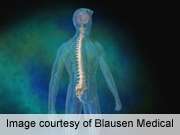American Society of Anesthesiologists class, age, and type of back surgery are independent risk factors for major medical complications, according to research published in the Sept. 1 issue of Spine.
(HealthDay)—American Society of Anesthesiologists (ASA) class, age, and type of back surgery are independent risk factors for major medical complications, according to research published in the Sept. 1 issue of Spine.
Richard A. Deyo, M.D., from the Oregon Health and Science University in Portland, and colleagues utilized the Veterans Affairs National Surgical Quality Improvement Program database to identify 12,154 patients who underwent surgery for a primary diagnosis of lumbar stenosis between 1998 and 2009. Major medical complications were defined using a composite which included acute myocardial infarction, stroke, pulmonary embolism, pneumonia, systemic sepsis, coma, and cardiac arrest.
The researchers found that major medical complications occurred in 2.1 percent of patients, wound complications in 3.2 percent, and 90-day mortality in 0.6 percent. There was a strong association with age and major medical complications, but not wound complications. Complications were also strongly predicted by ASA class as well as by insulin use, long-term corticosteroid use, and preoperative functional status. However, ASA class and age were the strongest predictors of major medical complications (odds ratio for ASA class 4 versus class 1 or 2, 2.97). Fusion procedures remained associated with higher medical complication rates than decompressions alone, when adjusting for comorbidity, age, and functional status (odds ratio, 2.85).
"These factors may help in selecting patients and planning procedures, improving patient safety," the authors write.
More information:
Abstract
Full Text (subscription or payment may be required)
Journal information: Spine
Copyright © 2013 HealthDay. All rights reserved.






















